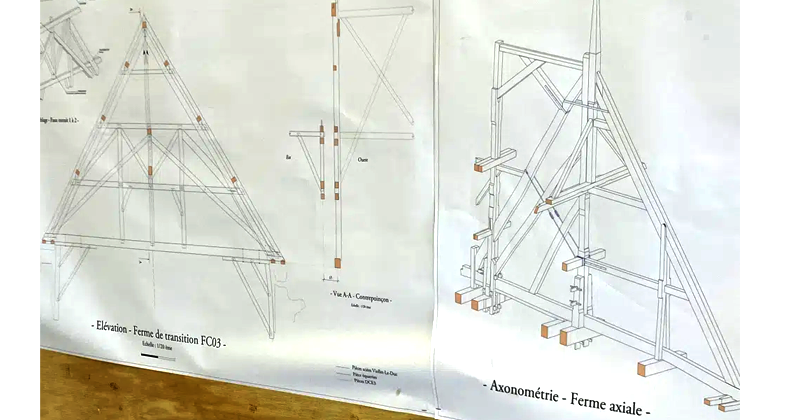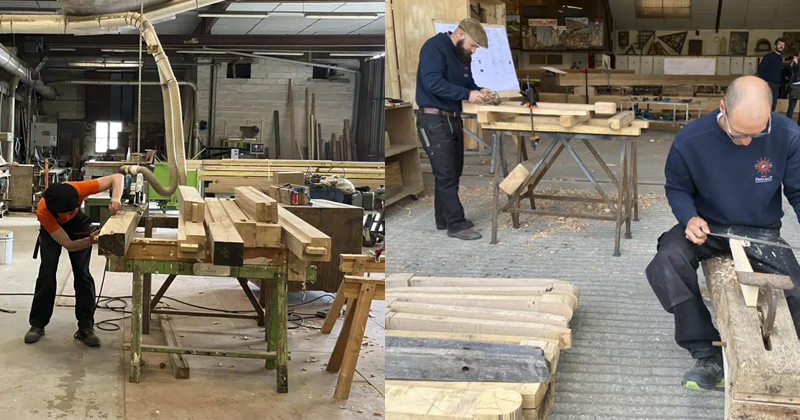Saint-Laurent-De-La-Plaine, France - If the concept of time travel were to become a reality, medieval carpenters would undoubtedly be astounded by the utilization of their pioneering woodworking techniques, originally employed over 800 years ago in the construction of Notre Dame Cathedral. These very techniques are now being employed once again to reconstruct the roof of this renowned monument, which was severely damaged by fire.
Conversely, modern-day carpenters are experiencing a reverse fascination as they skillfully employ medieval-era methods. Utilizing hand axes to craft massive quantities of oak beams for the new roof structure of Notre Dame has transported them back in time. This process has instilled within them a profound admiration for the craftsmanship of their predecessors, who fearlessly pushed the boundaries of architectural innovation during the 13th century.
Peter Henrikson, one of the carpenters involved in the restoration, describes the experience as occasionally bewildering. While vigorously striking a mallet upon a chisel, he often ponders the medieval craftsmen who, nearly a millennium ago, meticulously executed "essentially the same joint."
"It's truly captivating," he remarks. "In many ways, we are likely contemplating similar thoughts." The deliberate decision to employ hand tools in the restoration of the roof, which was reduced to ashes by the flames in 2019, is a thoughtful and intentional choice. Despite the undeniable efficiency of power tools, the objective is to honor the remarkable craftsmanship of the cathedral's original builders and preserve the centuries-old tradition of handcrafted woodwork.
"We aspire to restore this cathedral in the same manner as it was constructed during the Middle Ages," emphasizes Jean-Louis Georgelin, the retired French army general overseeing the reconstruction.

"This approach serves as a testament to the meticulous workmanship exhibited by all those who contributed to the creation of France's extraordinary architectural treasures."
Given the pressing deadline to reopen the cathedral by December 2024, carpenters and architects have also integrated computer design and other modern technologies to expedite the reconstruction process. Computers have been employed to create detailed plans for carpenters, ensuring precise alignment of their meticulously chiseled beams.
Henrikson reflects, "The traditional carpenters possessed an immense wealth of knowledge. It's truly remarkable to contemplate how they accomplished such feats with the limited tools and technology available to them at that time."

Hailing from Grand Marais, Minnesota, the 61-year-old American carpenter is part of a team predominantly comprised of French artisans who are working on the timber frame. An important milestone in the roof reconstruction was achieved in May when substantial portions of the new timber frame were assembled and erected at a workshop located in the Loire Valley, situated in western France.
This preliminary run ensured that the frame is suitable for its intended purpose. The subsequent assembly will take place atop the cathedral, unlike in medieval times, with the frame being transported to Paris and hoisted into position using mechanical cranes. Approximately 1,200 trees were felled for this endeavor.
Architect Remi Fromont, who meticulously drew detailed plans of the original frame back in 2012, explains, "Our objective was to restore the wooden frame structure to its original state, which was lost in the fire on April 15, 2019."
The rebuilt frame mirrors the identical wooden structure from the 13th century, utilizing the same material—oak—and employing the exact tools, including the same axes. The expertise and craftsmanship remain unchanged. In due course, it will reclaim its rightful place. "It is, without a doubt," he adds, "a true resurrection."
